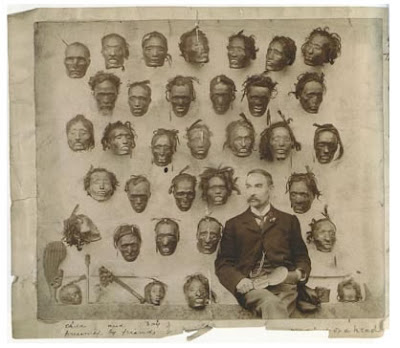


British soldier Horatio Gordon Robley (1840-1930) was deployed to New Zealand in 1864, where the military took advantage of his artistic abilities to sketch enemy territory during the land disputes with natives. Maj. General Robley completed a series of detailed sketches of the Māori defenses at Pukehinahina, but also did accurate drawings of the Māori tattoo designs of the wounded and dead (example, 2nd image), and studied their language and culture. The tattoos were called "moki" and the heads of men who had the designs were often preserved. (The method involved removing the contents, sealing the orifices, smoking, sun-drying, and rubbing with shark oil.) The preserved heads - mokomokai - would be brought out for sacred ceremonies. Those of enemy chiefs kept as trophies were bargaining chips with warring tribes.
Retiring after a lifetime of service in the British Army, Robley took up his interest in Māori tattooing. Not only did he write books about them, he decided to acquire as many examples as he could. Eventually his specimens of Mokomokai numbered 35 heads (1st image). The New Zealand Government declined Robley's 1908 offer to sell the collection for £1,000, but the American Museum of Natural History later paid the equivalent of £1,250 for it - minus the 5 best examples which Robley retained. In 1998, the heads curated by the museum were repatriated to New Zealand.
The news today is that the Museum of Rouen in northern France has just repatriated a Māori head that they acquired in 1875, one of more than a dozen which will be returned to New Zealand by French mueums. The photo of the ceremony shows that the artifact was covered by a cloth, but I wondered what the heads looked like, imagining them similar to shrunken heads and overmodeled skulls. I found an unidentified example (3rd image) and my search is what led to the photograph of Maj. General Robley and his collection. There are thought to be about 500 mokomokai in the world, of which more than half have been repatriated.









No comments:
Post a Comment
You may add your comments here.